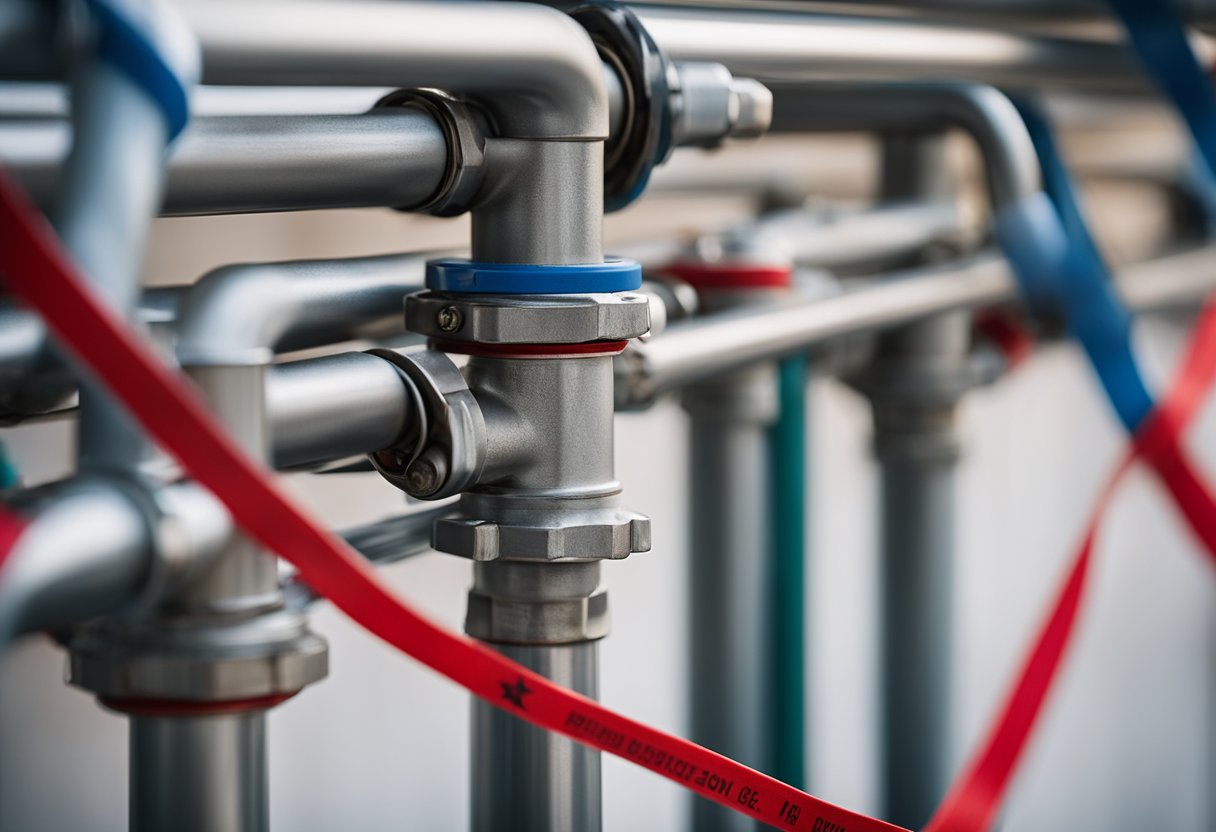PEX plumbing has been a popular alternative to copper and PVC pipes since its introduction in the 1960s. PEX stands for cross-linked polyethylene, which is a type of plastic material that is flexible, durable, and easy to install. However, despite its many benefits, some people have raised concerns about the safety and reliability of PEX plumbing.
One of the main reasons why PEX plumbing is controversial is because of the chemicals used in its production. PEX pipes are made from polyethylene, which is melted and extruded into a tube shape. During this process, various chemicals are added to the polyethylene to increase its strength and flexibility. Some of these chemicals, such as antioxidants, stabilizers, and lubricants, have been linked to health problems and environmental damage. Additionally, some people are concerned that PEX pipes may leach chemicals into the water supply, which could be harmful to human health.
Another issue with PEX plumbing is its susceptibility to damage from rodents and other pests. Unlike copper pipes, which are relatively hard and resistant to chewing, PEX pipes are made from a soft, flexible material that is easy for rodents to gnaw through. This can lead to leaks, water damage, and costly repairs. To prevent this, homeowners may need to take extra precautions, such as sealing off entry points and using rodent-proof insulation.
Understanding Pex Plumbing
PEX, or cross-linked polyethylene, is a type of plastic tubing that has been increasingly used in plumbing systems since the 1990s. PEX plumbing systems have gained popularity due to their flexibility, ease of installation, and affordability compared to traditional copper or steel pipes.
PEX plumbing systems consist of pipes, fittings, and valves made of PEX material. The pipes are available in various diameters and colors, and they can be installed using a variety of methods, such as crimping, compression, or push-fit connections.
PEX plumbing systems are typically used for hot and cold water distribution, radiant heating, and snow melting systems. They are also used for hydronic heating, which involves circulating hot water through radiators or baseboard heaters to heat a building.
Despite its advantages, there are some concerns about the safety and reliability of PEX plumbing systems. Some critics argue that PEX pipes may leach chemicals into the water supply, leading to potential health risks. Additionally, PEX pipes may be more prone to leaks and failures than traditional metal pipes, especially if they are installed improperly or exposed to extreme temperatures or chemicals.
However, it is important to note that many industry experts and government agencies have deemed PEX plumbing systems safe and reliable when installed according to manufacturer instructions and building codes. Homeowners should consult with a licensed plumber or building professional to determine if PEX plumbing is a suitable option for their specific needs and circumstances.
Concerns About Pex Plumbing
PEX plumbing has become a popular alternative to traditional copper and PVC pipes. However, there are concerns about the safety and durability of PEX plumbing that homeowners should be aware of.
Chemical Leaching
One of the main concerns about PEX plumbing is the potential for chemical leaching. PEX pipes are made of plastic, which can release chemicals into the water supply. According to MD Sewer, PEX pipes can release volatile organic compounds (VOCs) and other harmful chemicals that can contaminate drinking water.
While PEX pipes are approved for use in residential plumbing systems, some experts recommend that homeowners use a water filtration system to remove any potential contaminants.
Environmental Impact
Another concern about PEX plumbing is its environmental impact. PEX pipes are made from non-renewable fossil fuels, which can have a negative impact on the environment. Additionally, PEX pipes cannot be recycled and must be disposed of in a landfill.
Limited UV Resistance
PEX pipes are also susceptible to damage from UV radiation. According to Bob Vila, PEX pipes can become brittle and crack when exposed to sunlight. This can lead to leaks and other plumbing issues.
To prevent UV damage, PEX pipes should be installed in areas that are not exposed to direct sunlight or covered with insulation or other protective materials.
Overall, while PEX plumbing has some advantages over traditional plumbing materials, homeowners should be aware of the potential risks and drawbacks before making a decision.
Comparing Pex Plumbing with Other Materials
When it comes to plumbing, there are several materials available in the market. Two of the most common materials used in plumbing are PEX and copper. PVC is also another material used in plumbing, but it has its own limitations. In this section, we will compare PEX plumbing with copper and PVC plumbing.
Pex Vs Copper
Copper has been the traditional choice for plumbing for many years. Copper is known for its durability and strength. However, copper is more expensive than PEX. It is also difficult to install, which makes it more expensive to install. Copper pipes are prone to corrosion, which can lead to leaks. Copper pipes are also susceptible to freezing, which can cause them to burst.
PEX plumbing, on the other hand, is more affordable than copper. PEX is also easier to install than copper, which makes it less expensive to install. PEX is also more flexible than copper, which makes it easier to work with. PEX is also resistant to corrosion, which makes it less likely to leak. PEX is also resistant to freezing, which makes it less likely to burst.
Pex Vs PVC
PVC is another material used in plumbing. PVC is known for its affordability and ease of installation. However, PVC is not as durable as PEX. PVC is prone to cracking, which can lead to leaks. PVC is also not as flexible as PEX, which makes it more difficult to work with. PVC is also not resistant to freezing, which can cause it to burst.
PEX plumbing, on the other hand, is more durable than PVC. PEX is also more flexible than PVC, which makes it easier to work with. PEX is also resistant to freezing, which makes it less likely to burst. PEX is also resistant to cracking, which makes it less likely to leak.
In conclusion, PEX plumbing has several advantages over copper and PVC plumbing. PEX is more affordable, easier to install, more flexible, and more resistant to corrosion, freezing, and cracking.
Regulatory Issues Surrounding Pex Plumbing

PEX plumbing has been gaining popularity due to its numerous advantages over traditional plumbing materials. However, there are regulatory issues surrounding PEX plumbing that homeowners and contractors should be aware of.
One of the main concerns with PEX plumbing is the potential for leaching of chemicals into the water supply. PEX pipes are made of cross-linked polyethylene, which can release volatile organic compounds (VOCs) when exposed to high temperatures. These VOCs can contaminate the water supply and pose health risks to humans. As a result, some states have banned the use of PEX plumbing in certain applications.
Another regulatory issue with PEX plumbing is its compatibility with fire sprinkler systems. Some local building codes require the use of metal pipes for fire sprinkler systems, which are not compatible with PEX plumbing. This can lead to additional costs and complications for homeowners and contractors.
In addition, PEX plumbing has been subject to lawsuits and recalls due to defects in the fittings. Some PEX fittings have been found to fail prematurely, leading to leaks and water damage. Homeowners and contractors should be aware of any recalls or defects associated with PEX plumbing before installing it in their homes or buildings.
Overall, while PEX plumbing has many advantages, it is important to be aware of the regulatory issues surrounding its use. Homeowners and contractors should consult with local building codes and regulations before installing PEX plumbing, and ensure that any products used are compliant with safety standards.
How to Mitigate Pex Plumbing Issues
PEX plumbing has its limitations, but proper installation and regular maintenance can help mitigate the issues. Here are some tips to ensure your PEX plumbing system works efficiently and lasts longer.
Proper Installation
Proper installation is crucial for the longevity and efficiency of PEX plumbing. Here are some tips to ensure your PEX plumbing is installed correctly:
- Hire a licensed and experienced plumber who is familiar with PEX plumbing.
- Use the correct fittings and connectors recommended by the manufacturer.
- Ensure the fittings are properly crimped or clamped to prevent leaks.
- Avoid using sharp tools that can damage the pipes during installation.
- Follow the manufacturer’s guidelines for minimum bending radius and maximum water pressure.
Regular Maintenance
Regular maintenance can help prevent issues with PEX plumbing. Here are some maintenance tips to keep your PEX plumbing system in good condition:
- Inspect the pipes and fittings regularly for signs of leaks, corrosion, or damage.
- Check the water pressure regularly and adjust it to the recommended level.
- Insulate the pipes in cold areas to prevent freezing and bursting.
- Avoid exposing the pipes to direct sunlight or extreme temperatures.
- Use water softeners or filters to prevent mineral buildup that can clog the pipes.
By following these tips, homeowners can mitigate the issues associated with PEX plumbing. Proper installation and regular maintenance can help ensure that the system works efficiently and lasts longer.
Frequently Asked Questions

What are the pros and cons of using PEX plumbing?
PEX plumbing has many advantages, including its flexibility, resistance to corrosion, and ability to expand and contract without bursting. It is also relatively easy to install and can save homeowners money on installation costs. However, PEX plumbing has some disadvantages, including its susceptibility to damage from UV light and chemicals, its relatively short lifespan compared to copper plumbing, and concerns about potential health risks associated with certain types of PEX plumbing.
Is PEX plumbing safe for drinking water?
PEX plumbing is generally considered safe for drinking water, but there are some concerns about the potential for chemicals to leach from certain types of PEX plumbing. Some studies have suggested that PEX plumbing may release harmful chemicals into drinking water, but more research is needed to determine the extent of the risk.
Why do some plumbers prefer copper over PEX?
Some plumbers prefer copper plumbing over PEX plumbing because of its durability, resistance to UV light and chemicals, and long lifespan. Copper plumbing is also less likely to be damaged by rodents and other pests, which can chew through PEX plumbing.
What is the controversy surrounding PEX plumbing?
The controversy surrounding PEX plumbing centers on concerns about potential health risks associated with certain types of PEX plumbing. Some studies have suggested that PEX plumbing may release harmful chemicals into drinking water, but more research is needed to determine the extent of the risk. Additionally, there are concerns about the durability of certain types of PEX plumbing and their susceptibility to damage from UV light and chemicals.
How long can PEX plumbing last?
PEX plumbing can last anywhere from 20 to 50 years, depending on the quality of the materials and the conditions under which it is installed. However, some types of PEX plumbing may have a shorter lifespan than copper plumbing and may be more susceptible to damage from UV light and chemicals.
Can PEX plumbing freeze and burst?
PEX plumbing is less likely to freeze and burst than copper plumbing, but it is still possible under certain conditions. To prevent PEX plumbing from freezing and bursting, homeowners should take steps to insulate their pipes and keep them warm during cold weather.
